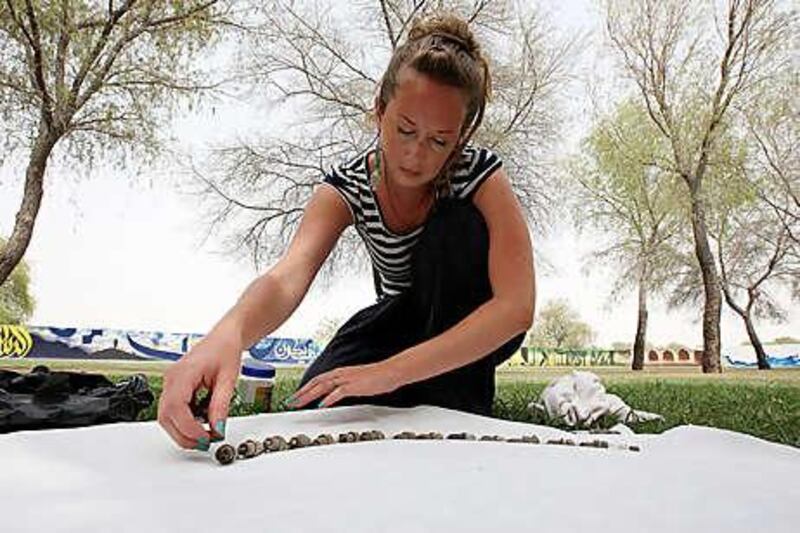DUBAI // On Christmas Day last year, Rebecca Rendell's husband gave her a large box full of scrap metal, old rubber tyres and broken glass.
It had taken him a week of scouring the streets of Ras Al Khaimah, where the couple live, to collect his present. "I was so pleased," Rendell said. "He saved me a lot of time and effort." Rendall, a 26-year-old British mixed media artist spends the days she is not collecting rubbish making art out of her finds at Tashkeel studios in Dubai. One of her work, Avifauna, is hanging in Ras Al Khaimah Hospital as part of the Tracking The Emirates Art Gate show.
The piece features 117 birds, fashioned out of the inner tubes of tyres fixed to a background of clouds. Another work, a collection of shells arranged in a geometric pattern on canvas, dubbed Rhinoclavis Kochi, took second prize in the Sheikha Manal Young Artist Award last year and was bought by a Dutch couple living in Dubai. Rendell was one of several female artists from the UAE chosen to have their work displayed at the United Nations Headquarters in New York in February in an exhibition called Reflective Mirror. She has also had work exhibited at Art Dubai and the Dubai Mall.
Rendell, who uses a regulated style to create symmetry and pattern out of the discarded junk, said she could not help but notice things around her. "We all see things differently," she said. "I see beauty where other people see waste. I like the idea of using something that no one else wants to use. It has to be completely useless to every other living creature before I take it from the environment."
Her first piece to be displayed in the UAE appeared in the Made in Tashkeel show in 2009. She collected hundreds of dead crabs from RAK beaches and fixed their claws in a circular pattern on the gallery wall. Her latest piece will be composed of mechanical parts, which has led her to garages to gather material. "At the moment, I am collecting spark plugs," she said. "If you weren't here with me, I would be out the back cleaning them with petrol."
Her work may be smelly, dirty and time consuming but it yields beautiful results, experts say. Kurt Blum, the manager of Swiss Art Gate UAE, a platform for promoting both Swiss and UAE-based artists, and the curator of the Tracking The Emirates show, said Rendell was "out of the box" with her style. "Rebecca changes the material and the subject according to the theme, but her expression is the same," he said. "She uses recycled and natural objects in mathematical patterns that remind me of Islamic art, she makes a relation between the objects and the patterns. Her work is finely crafted and it looks great."
Mr Blum said her Avifauna was "fantastic" because the tyres she used to make the birds had physically tracked the Emirates, and this is reflected in the birds doing the same thing as they appear to fly across the canvas. He has had two offers of around Dh6,000 for the piece but plans to wait until the exhibition ends on August 7 before making the final sale. Jill Hoyle, the manager of Tashkeel, said Rendell was not the only artist in the UAE to use found objects to make art.
Darwin Guevarra is a Filipino who creates chaotic combinations out of modern detritus such as fake gold watches, pieces of wooden mannequins and electrical circuit boards. He had his first solo exhibition in the Tashkeel House at Bastakiya Art Fair in March. In a self-portrait, he is submerged in a sea of random objects with a painted white face. "I like to take a useless thing and give it the chance to be part of a collection of history," Mr Guevarra said. "I am also a nature lover and caring for our environment is a duty to the next generation."
Although the two artistic styles are different, they share the common feature of using abandoned and seemingly worthless objects. Ms Hoyle said: "Darwin's objects are reflective of his life story and each one has significance whereas Rebecca's show her sensitivity to the environment she is living in. "Nevertheless both have this need to create and are motivated by things they find around them. From my experience in the UAE, I think this is quite unusual."
Guevarra has had to work hard to establish himself as an artist. His first watercolours were painted from shadows projected by lanterns on the walls of his family's home. Their electricity had been cut off when he could not pay the bills. "If he can't find money to buy materials he will find the materials in everyday objects," Ms Hoyle said. Rendell said the message behind her work was also one of resourcefulness. Raised on a farm in south Wales, she grew up aware of the natural environment.
"The process of collection and sorting is as important to me as the final work. I try to turn negative environmental changes into something positive. "In the UAE it can be easy to lose a sense of resourcefulness when a lot is available to you, so I am doing my small part in showing people not everything that looks like waste is waste." aseaman@thenational.ae






